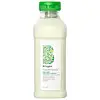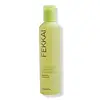What's inside
What's inside
 Key Ingredients
Key Ingredients

No key ingredients
 Benefits
Benefits

 Concerns
Concerns

 Ingredients Side-by-side
Ingredients Side-by-side

Water
Skin ConditioningGlycerin
HumectantIsopropyl Palmitate
EmollientBehentrimonium Chloride
PreservativeCetearyl Alcohol
EmollientBrassica Alcohol
EmollientCetyl Esters
EmollientBrassica Oleracea Acephala Leaf Extract
HumectantPyrus Malus Fruit Extract
Skin ConditioningSpinacia Oleracea Leaf Extract
Skin ConditioningBrassica Oleracea Italica Extract
AstringentPersea Gratissima Oil
Skin ConditioningCucumis Sativus Fruit Extract
EmollientPrunus Amygdalus Dulcis Oil
Skin ConditioningCitrus Limon Fruit Extract
MaskingCitrus Grandis Fruit Extract
AstringentCitrus Aurantium Dulcis Fruit Extract
MaskingZingiber Officinale Root Extract
MaskingBeta Vulgaris Root Extract
Skin ConditioningPanax Ginseng Root Extract
EmollientHippophae Rhamnoides Fruit Oil
Skin ProtectingChlorella Vulgaris Extract
Skin ConditioningBrassicyl Isoleucinate Esylate
Emulsion StabilisingPanthenol
Skin ConditioningCetrimonium Chloride
AntimicrobialBehentrimonium Methosulfate
Guar Hydroxypropyltrimonium Chloride
Skin ConditioningDehydroacetic Acid
PreservativeSodium Hydroxide
BufferingBenzyl Alcohol
PerfumingParfum
MaskingCI 75810
Cosmetic ColorantWater, Glycerin, Isopropyl Palmitate, Behentrimonium Chloride, Cetearyl Alcohol, Brassica Alcohol, Cetyl Esters, Brassica Oleracea Acephala Leaf Extract, Pyrus Malus Fruit Extract, Spinacia Oleracea Leaf Extract, Brassica Oleracea Italica Extract, Persea Gratissima Oil, Cucumis Sativus Fruit Extract, Prunus Amygdalus Dulcis Oil, Citrus Limon Fruit Extract, Citrus Grandis Fruit Extract, Citrus Aurantium Dulcis Fruit Extract, Zingiber Officinale Root Extract, Beta Vulgaris Root Extract, Panax Ginseng Root Extract, Hippophae Rhamnoides Fruit Oil, Chlorella Vulgaris Extract, Brassicyl Isoleucinate Esylate, Panthenol, Cetrimonium Chloride, Behentrimonium Methosulfate, Guar Hydroxypropyltrimonium Chloride, Dehydroacetic Acid, Sodium Hydroxide, Benzyl Alcohol, Parfum, CI 75810
Water
Skin ConditioningSodium Cocoyl Isethionate
CleansingSodium Lauroyl Methyl Isethionate
CleansingLauryl Glucoside
CleansingHeptyl Glucoside
Disteareth-75 Ipdi
Coconut Acid
CleansingPunica Granatum Seed Oil Stearyl Esters
EmollientGlyceryl Oleate
EmollientPyrus Malus Fruit Extract
Skin ConditioningVinegar
Sorbitan Oleate
EmulsifyingSodium Isethionate
CleansingGlycerin
HumectantHydroxypropyl Guar Hydroxypropyltrimonium Chloride
Zingiber Officinale Root Extract
MaskingCaprylyl/Capryl Glucoside
CleansingMagnolia Officinalis Bark Extract
AntimicrobialPanthenol
Skin ConditioningXylitol
HumectantEpilobium Angustifolium Flower/Leaf/Stem Extract
Skin ConditioningPhaeodactylum Tricornutum Extract
HumectantPiper Nigrum Seed Extract
RefreshingLeptospermum Scoparium Branch/Leaf Oil
TonicSalvia Hispanica Seed Extract
EmollientCaesalpinia Spinosa Fruit Extract
Skin ProtectingLavandula Angustifolia Flower Extract
CleansingPelvetia Canaliculata Extract
Skin ProtectingLeontopodium Alpinum Extract
Skin ConditioningHydrolyzed Vegetable Protein
Skin ConditioningOryza Sativa Seed Protein
AntioxidantOryza Sativa Bran Extract
Skin ConditioningOryza Sativa Extract
AbsorbentHelianthus Annuus Sprout Extract
Skin ConditioningHelianthus Annuus Extract
EmollientRosmarinus Officinalis Leaf Extract
AntimicrobialSalicylic Acid
MaskingGalactaric Acid
Trehalose
HumectantArginine PCA
HumectantMaltodextrin
AbsorbentHydroxypropyl Methylcellulose Stearoxy Ether
Ethyl Oleate
EmollientPolyquaternium-37
Tocopherol
AntioxidantEthyl Linoleate
EmollientGluconolactone
Skin ConditioningCalcium Gluconate
HumectantOctyldodecanol
EmollientSodium Phosphate
BufferingEthylhexylglycerin
Skin ConditioningPotassium Sorbate
PreservativeSodium Benzoate
MaskingChlorphenesin
AntimicrobialBenzyl Alcohol
PerfumingAlcohol
AntimicrobialPhenoxyethanol
PreservativeCaprylyl Glycol
EmollientCaprylic Acid
CleansingParfum
MaskingPhytic Acid
Sodium Phytate
Trisodium Ethylenediamine Disuccinate
Sodium Metabisulfite
AntioxidantPentaerythrityl Tetra-Di-T-Butyl Hydroxyhydrocinnamate
AntioxidantTbhq
AntioxidantLimonene
PerfumingGeraniol
PerfumingLinalool
PerfumingCitronellol
PerfumingCitral
PerfumingEugenol
PerfumingHexyl Cinnamal
PerfumingAmyl Cinnamal
PerfumingCitric Acid
BufferingPotassium Hydroxide
BufferingWater, Sodium Cocoyl Isethionate, Sodium Lauroyl Methyl Isethionate, Lauryl Glucoside, Heptyl Glucoside, Disteareth-75 Ipdi, Coconut Acid, Punica Granatum Seed Oil Stearyl Esters, Glyceryl Oleate, Pyrus Malus Fruit Extract, Vinegar, Sorbitan Oleate, Sodium Isethionate, Glycerin, Hydroxypropyl Guar Hydroxypropyltrimonium Chloride, Zingiber Officinale Root Extract, Caprylyl/Capryl Glucoside, Magnolia Officinalis Bark Extract, Panthenol, Xylitol, Epilobium Angustifolium Flower/Leaf/Stem Extract, Phaeodactylum Tricornutum Extract, Piper Nigrum Seed Extract, Leptospermum Scoparium Branch/Leaf Oil, Salvia Hispanica Seed Extract, Caesalpinia Spinosa Fruit Extract, Lavandula Angustifolia Flower Extract, Pelvetia Canaliculata Extract, Leontopodium Alpinum Extract, Hydrolyzed Vegetable Protein, Oryza Sativa Seed Protein, Oryza Sativa Bran Extract, Oryza Sativa Extract, Helianthus Annuus Sprout Extract, Helianthus Annuus Extract, Rosmarinus Officinalis Leaf Extract, Salicylic Acid, Galactaric Acid, Trehalose, Arginine PCA, Maltodextrin, Hydroxypropyl Methylcellulose Stearoxy Ether, Ethyl Oleate, Polyquaternium-37, Tocopherol, Ethyl Linoleate, Gluconolactone, Calcium Gluconate, Octyldodecanol, Sodium Phosphate, Ethylhexylglycerin, Potassium Sorbate, Sodium Benzoate, Chlorphenesin, Benzyl Alcohol, Alcohol, Phenoxyethanol, Caprylyl Glycol, Caprylic Acid, Parfum, Phytic Acid, Sodium Phytate, Trisodium Ethylenediamine Disuccinate, Sodium Metabisulfite, Pentaerythrityl Tetra-Di-T-Butyl Hydroxyhydrocinnamate, Tbhq, Limonene, Geraniol, Linalool, Citronellol, Citral, Eugenol, Hexyl Cinnamal, Amyl Cinnamal, Citric Acid, Potassium Hydroxide
Ingredients Explained
These ingredients are found in both products.
Ingredients higher up in an ingredient list are typically present in a larger amount.
Benzyl Alcohol is most commonly used as a preservative. It also has a subtle, sweet smell. Small amounts of Benzyl Alcohol is not irritating and safe to use in skincare products. Most Benzyl Alcohol is derived from fruits such as apricots.
Benzyl Alcohol has both antibacterial and antioxidant properties. These properties help lengthen the shelf life of products. Benzyl Alcohol is a solvent and helps dissolve other ingredients. It can also improve the texture and spreadability.
Alcohol comes in many different forms. Different types of alcohol will have different effects on skin. This ingredient is an astringent alcohol.
Using high concentrations of these alcohols are drying on the skin. They may strip away your skin's natural oils and even damage your skin barrier. Astringent alcohols may also irritate skin.
Other types of astringent alcohols include:
According to the National Rosacea Society based in the US, you should be mindful of products with these alcohols in the top half of ingredients.
Any type of sanitizing product will have high amounts of alcohol to help kill bacteria and viruses.
Learn more about Benzyl AlcoholGlycerin is already naturally found in your skin. It helps moisturize and protect your skin.
A study from 2016 found glycerin to be more effective as a humectant than AHAs and hyaluronic acid.
As a humectant, it helps the skin stay hydrated by pulling moisture to your skin. The low molecular weight of glycerin allows it to pull moisture into the deeper layers of your skin.
Hydrated skin improves your skin barrier; Your skin barrier helps protect against irritants and bacteria.
Glycerin has also been found to have antimicrobial and antiviral properties. Due to these properties, glycerin is often used in wound and burn treatments.
In cosmetics, glycerin is usually derived from plants such as soybean or palm. However, it can also be sourced from animals, such as tallow or animal fat.
This ingredient is organic, colorless, odorless, and non-toxic.
Glycerin is the name for this ingredient in American English. British English uses Glycerol/Glycerine.
Learn more about GlycerinPanthenol is a common ingredient that helps hydrate and soothe the skin. It is found naturally in our skin and hair.
There are two forms of panthenol: D and L.
D-panthenol is also known as dexpanthenol. Most cosmetics use dexpanthenol or a mixture of D and L-panthenol.
Panthenol is famous due to its ability to go deeper into the skin's layers. Using this ingredient has numerous pros (and no cons):
Like hyaluronic acid, panthenol is a humectant. Humectants are able to bind and hold large amounts of water to keep skin hydrated.
This ingredient works well for wound healing. It works by increasing tissue in the wound and helps close open wounds.
Once oxidized, panthenol converts to pantothenic acid. Panthothenic acid is found in all living cells.
This ingredient is also referred to as pro-vitamin B5.
Learn more about PanthenolParfum is a catch-all term for an ingredient or more that is used to give a scent to products.
Also called "fragrance", this ingredient can be a blend of hundreds of chemicals or plant oils. This means every product with "fragrance" or "parfum" in the ingredients list is a different mixture.
For instance, Habanolide is a proprietary trade name for a specific aroma chemical. When used as a fragrance ingredient in cosmetics, most aroma chemicals fall under the broad labeling category of “FRAGRANCE” or “PARFUM” according to EU and US regulations.
The term 'parfum' or 'fragrance' is not regulated in many countries. In many cases, it is up to the brand to define this term.
For instance, many brands choose to label themselves as "fragrance-free" because they are not using synthetic fragrances. However, their products may still contain ingredients such as essential oils that are considered a fragrance by INCI standards.
One example is Calendula flower extract. Calendula is an essential oil that still imparts a scent or 'fragrance'.
Depending on the blend, the ingredients in the mixture can cause allergies and sensitivities on the skin. Some ingredients that are known EU allergens include linalool and citronellol.
Parfum can also be used to mask or cover an unpleasant scent.
The bottom line is: not all fragrances/parfum/ingredients are created equally. If you are worried about fragrances, we recommend taking a closer look at an ingredient. And of course, we always recommend speaking with a professional.
Learn more about ParfumPyrus Malus Fruit Extract is extract from Apples. Apples are rich in Vitamin C, sugars, and antioxidants.
The sugar in Apples are humectants and help hydrate the skin. On top of that, apples also contain some acids, such as malic acid. These acids may have a mild exfoliating effect.
Last, the phytochemicals found in apples are strong antioxidants. These antioxidants help with anti-aging as they protect your skin cells against oxidative damage.
Learn more about Pyrus Malus Fruit ExtractWater. It's the most common cosmetic ingredient of all. You'll usually see it at the top of ingredient lists, meaning that it makes up the largest part of the product.
So why is it so popular? Water most often acts as a solvent - this means that it helps dissolve other ingredients into the formulation.
You'll also recognize water as that liquid we all need to stay alive. If you see this, drink a glass of water. Stay hydrated!
Learn more about WaterZingiber Officinale is more commonly known as ginger.
Ginger root has antioxidant, anti-inflammation, and antimicrobial properties.
The antioxidant properties help protect your body from free-radicals. Free-radicals are molecules that may damage your skin cells. As a result, ginger may help slow down signs of aging such as hyperpigmentation and wrinkles.
Studies show ginger inhibits the enzyme that breaks down collagen. It also helps with:
This ingredient has no negative side-effects and is safe to use unless one has a specific allergy to it.
Ginger originates from Southeast Asia but has spread throughout the world. It is now a common spice used in many cultures.
Learn more about Zingiber Officinale Root Extract